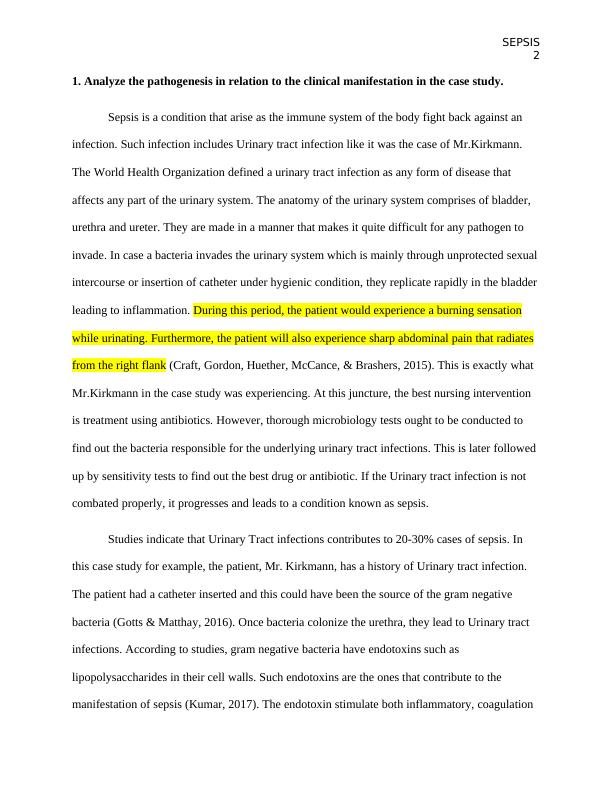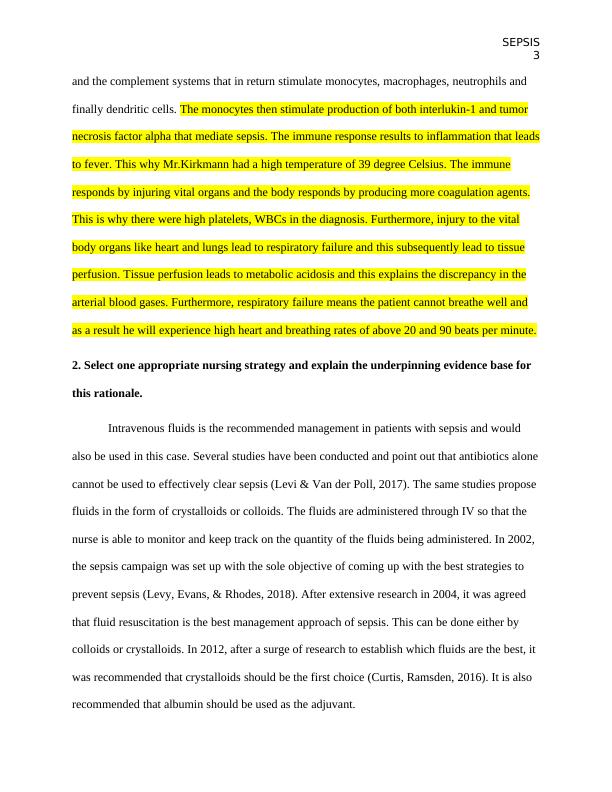Analyzing Pathogenesis and Clinical Manifestation of Sepsis
Added on 2023-01-11
7 Pages1846 Words76 Views
Running head: SEPSIS
1
Sepsis
Name
Institution
Tutor
Date:
1
Sepsis
Name
Institution
Tutor
Date:

SEPSIS
2
1. Analyze the pathogenesis in relation to the clinical manifestation in the case study.
Sepsis is a condition that arise as the immune system of the body fight back against an
infection. Such infection includes Urinary tract infection like it was the case of Mr.Kirkmann.
The World Health Organization defined a urinary tract infection as any form of disease that
affects any part of the urinary system. The anatomy of the urinary system comprises of bladder,
urethra and ureter. They are made in a manner that makes it quite difficult for any pathogen to
invade. In case a bacteria invades the urinary system which is mainly through unprotected sexual
intercourse or insertion of catheter under hygienic condition, they replicate rapidly in the bladder
leading to inflammation. During this period, the patient would experience a burning sensation
while urinating. Furthermore, the patient will also experience sharp abdominal pain that radiates
from the right flank (Craft, Gordon, Huether, McCance, & Brashers, 2015). This is exactly what
Mr.Kirkmann in the case study was experiencing. At this juncture, the best nursing intervention
is treatment using antibiotics. However, thorough microbiology tests ought to be conducted to
find out the bacteria responsible for the underlying urinary tract infections. This is later followed
up by sensitivity tests to find out the best drug or antibiotic. If the Urinary tract infection is not
combated properly, it progresses and leads to a condition known as sepsis.
Studies indicate that Urinary Tract infections contributes to 20-30% cases of sepsis. In
this case study for example, the patient, Mr. Kirkmann, has a history of Urinary tract infection.
The patient had a catheter inserted and this could have been the source of the gram negative
bacteria (Gotts & Matthay, 2016). Once bacteria colonize the urethra, they lead to Urinary tract
infections. According to studies, gram negative bacteria have endotoxins such as
lipopolysaccharides in their cell walls. Such endotoxins are the ones that contribute to the
manifestation of sepsis (Kumar, 2017). The endotoxin stimulate both inflammatory, coagulation
2
1. Analyze the pathogenesis in relation to the clinical manifestation in the case study.
Sepsis is a condition that arise as the immune system of the body fight back against an
infection. Such infection includes Urinary tract infection like it was the case of Mr.Kirkmann.
The World Health Organization defined a urinary tract infection as any form of disease that
affects any part of the urinary system. The anatomy of the urinary system comprises of bladder,
urethra and ureter. They are made in a manner that makes it quite difficult for any pathogen to
invade. In case a bacteria invades the urinary system which is mainly through unprotected sexual
intercourse or insertion of catheter under hygienic condition, they replicate rapidly in the bladder
leading to inflammation. During this period, the patient would experience a burning sensation
while urinating. Furthermore, the patient will also experience sharp abdominal pain that radiates
from the right flank (Craft, Gordon, Huether, McCance, & Brashers, 2015). This is exactly what
Mr.Kirkmann in the case study was experiencing. At this juncture, the best nursing intervention
is treatment using antibiotics. However, thorough microbiology tests ought to be conducted to
find out the bacteria responsible for the underlying urinary tract infections. This is later followed
up by sensitivity tests to find out the best drug or antibiotic. If the Urinary tract infection is not
combated properly, it progresses and leads to a condition known as sepsis.
Studies indicate that Urinary Tract infections contributes to 20-30% cases of sepsis. In
this case study for example, the patient, Mr. Kirkmann, has a history of Urinary tract infection.
The patient had a catheter inserted and this could have been the source of the gram negative
bacteria (Gotts & Matthay, 2016). Once bacteria colonize the urethra, they lead to Urinary tract
infections. According to studies, gram negative bacteria have endotoxins such as
lipopolysaccharides in their cell walls. Such endotoxins are the ones that contribute to the
manifestation of sepsis (Kumar, 2017). The endotoxin stimulate both inflammatory, coagulation

SEPSIS
3
and the complement systems that in return stimulate monocytes, macrophages, neutrophils and
finally dendritic cells. The monocytes then stimulate production of both interlukin-1 and tumor
necrosis factor alpha that mediate sepsis. The immune response results to inflammation that leads
to fever. This why Mr.Kirkmann had a high temperature of 39 degree Celsius. The immune
responds by injuring vital organs and the body responds by producing more coagulation agents.
This is why there were high platelets, WBCs in the diagnosis. Furthermore, injury to the vital
body organs like heart and lungs lead to respiratory failure and this subsequently lead to tissue
perfusion. Tissue perfusion leads to metabolic acidosis and this explains the discrepancy in the
arterial blood gases. Furthermore, respiratory failure means the patient cannot breathe well and
as a result he will experience high heart and breathing rates of above 20 and 90 beats per minute.
2. Select one appropriate nursing strategy and explain the underpinning evidence base for
this rationale.
Intravenous fluids is the recommended management in patients with sepsis and would
also be used in this case. Several studies have been conducted and point out that antibiotics alone
cannot be used to effectively clear sepsis (Levi & Van der Poll, 2017). The same studies propose
fluids in the form of crystalloids or colloids. The fluids are administered through IV so that the
nurse is able to monitor and keep track on the quantity of the fluids being administered. In 2002,
the sepsis campaign was set up with the sole objective of coming up with the best strategies to
prevent sepsis (Levy, Evans, & Rhodes, 2018). After extensive research in 2004, it was agreed
that fluid resuscitation is the best management approach of sepsis. This can be done either by
colloids or crystalloids. In 2012, after a surge of research to establish which fluids are the best, it
was recommended that crystalloids should be the first choice (Curtis, Ramsden, 2016). It is also
recommended that albumin should be used as the adjuvant.
3
and the complement systems that in return stimulate monocytes, macrophages, neutrophils and
finally dendritic cells. The monocytes then stimulate production of both interlukin-1 and tumor
necrosis factor alpha that mediate sepsis. The immune response results to inflammation that leads
to fever. This why Mr.Kirkmann had a high temperature of 39 degree Celsius. The immune
responds by injuring vital organs and the body responds by producing more coagulation agents.
This is why there were high platelets, WBCs in the diagnosis. Furthermore, injury to the vital
body organs like heart and lungs lead to respiratory failure and this subsequently lead to tissue
perfusion. Tissue perfusion leads to metabolic acidosis and this explains the discrepancy in the
arterial blood gases. Furthermore, respiratory failure means the patient cannot breathe well and
as a result he will experience high heart and breathing rates of above 20 and 90 beats per minute.
2. Select one appropriate nursing strategy and explain the underpinning evidence base for
this rationale.
Intravenous fluids is the recommended management in patients with sepsis and would
also be used in this case. Several studies have been conducted and point out that antibiotics alone
cannot be used to effectively clear sepsis (Levi & Van der Poll, 2017). The same studies propose
fluids in the form of crystalloids or colloids. The fluids are administered through IV so that the
nurse is able to monitor and keep track on the quantity of the fluids being administered. In 2002,
the sepsis campaign was set up with the sole objective of coming up with the best strategies to
prevent sepsis (Levy, Evans, & Rhodes, 2018). After extensive research in 2004, it was agreed
that fluid resuscitation is the best management approach of sepsis. This can be done either by
colloids or crystalloids. In 2012, after a surge of research to establish which fluids are the best, it
was recommended that crystalloids should be the first choice (Curtis, Ramsden, 2016). It is also
recommended that albumin should be used as the adjuvant.

End of preview
Want to access all the pages? Upload your documents or become a member.
Related Documents
Urinary Tract Infection with Sepsislg...
|7
|1908
|1
A Case Study on Urosepsislg...
|7
|1800
|84
Urosepsis: Pathogenesis, Nursing Strategy, and Analysis of Arterial Blood Gaseslg...
|7
|1868
|95
Urinary Tract Infection with Sepsislg...
|8
|1765
|44
Case Study on Urosepsislg...
|6
|1636
|94
Urinary Tract Infection with Sepsislg...
|8
|1877
|97
